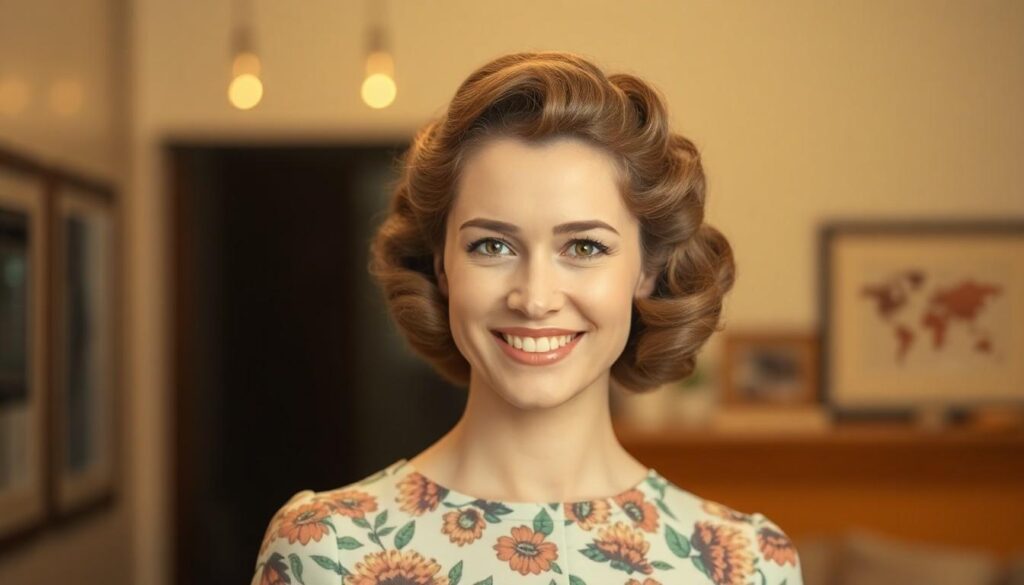There’s something irresistibly charming about the hairstyles of the 1940s. These iconic looks blend elegance with a touch of old Hollywood glamour and they’ve never truly gone out of style. Whether we’re drawn to the polished waves or the playful victory rolls there’s a timeless appeal that keeps us coming back for more.
We all crave a bit of vintage flair in our everyday look and the 40s offer endless inspiration. With just a few styling tricks we can channel the confidence and sophistication of that golden era. Let’s rediscover the magic of fascinating 40s hairstyles and see how these classic trends can transform our style today.
Exploring Iconic Victory Rolls
Victory rolls instantly bring a sense of drama and polish that defines 1940s hair. We can easily recognize their bold curves in both vintage photographs and modern runway reinterpretations.
How Victory Rolls Became a 40s Staple
Women embraced victory rolls during the 1940s as a symbol of resilience and patriotic pride. Hollywood stars like Rita Hayworth and Veronica Lake made the look iconic, and everyday women quickly followed their lead. Factories and military roles required practical styles, so victory rolls helped keep hair out of the face while still looking glamorous. Salons and magazines frequently featured step-by-step guides, cementing victory rolls as the decade’s signature statement.
Step-by-Step Guide to Creating Victory Rolls
We start by parting our hair to one side, setting the foundation for even, balanced rolls. Next, we separate a generous section from the front, then gently tease the roots for volume and grip. Holding the end of this section, we roll the hair inward toward the scalp, creating the classic swirl. Carefully pinning the roll in place with sturdy bobby pins secures the shape. Lightly misting with hairspray ensures the style holds all day. Repeating the process on the opposite side gives us a flawless, symmetrical finish every time.
Embracing Elegant Pin Curls
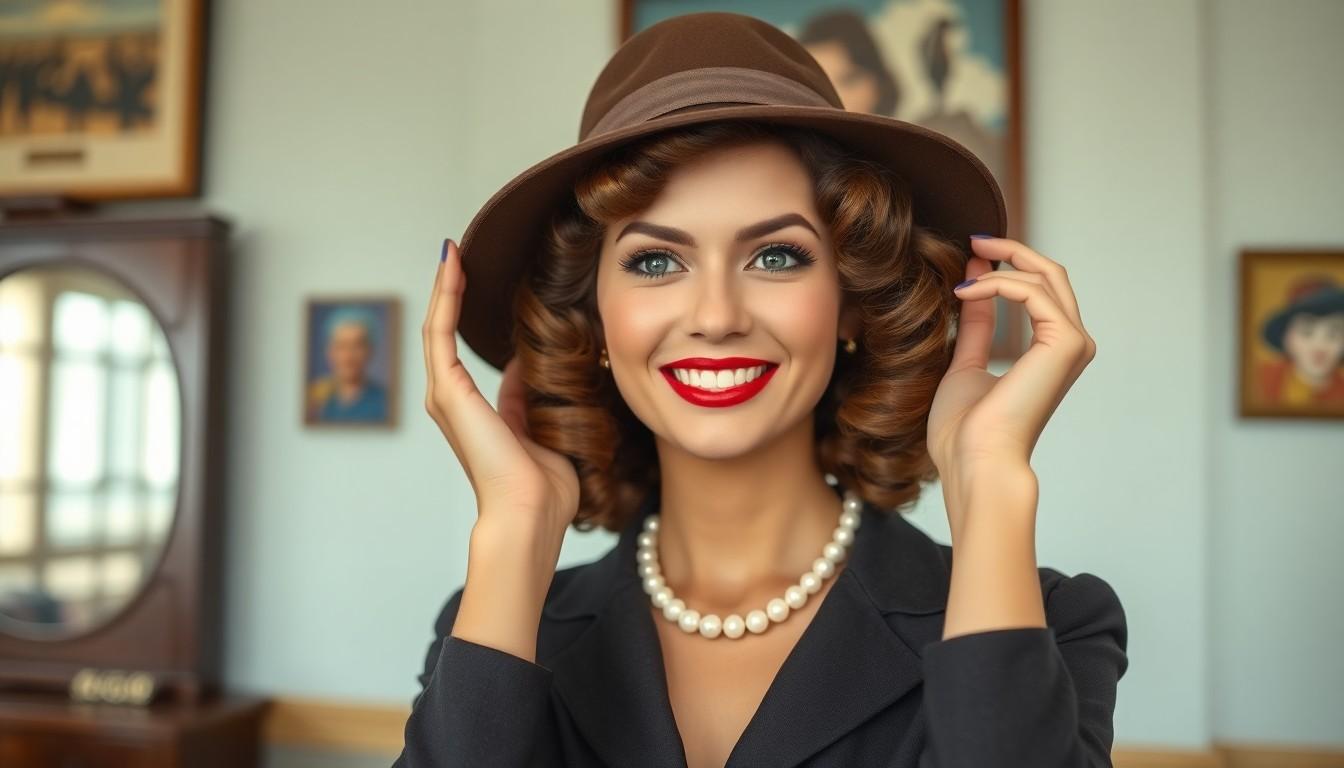
Pin curls became a signature look in the 1940s, giving everyday style a dose of glamour. We can still appreciate their timeless elegance and practical charm.
The Popularity of Pin Curls in the 1940s
Pin curls swept through the 1940s as the go-to choice for full, rounded shapes and soft waves. Our grandmothers and iconic film stars alike wore these styles, often cutting hair in a curved U-shape that stopped just below the shoulders. Nearly everyone in that decade considered straight hair dull, preferring curls, waves, and even gelled looks. Salons and at-home routines focused on creating these lively textures every day. Victory rolls and pin curls carried deeper meaning, too—styles like these symbolized encouragement and victory, a nod to wartime resilience. Even for women wearing hats, pin curls let us keep hair neat, off our faces, and always on trend.
Tips for Perfecting Glamorous Pin Curls
We find that achieving gorgeous 1940s pin curls starts with layering. Fine or thick, our hair responds best when it’s cut with plenty of layers, making it curl easily and build volume. Next, prepping hair is key. Many women set their curls by pinning up damp strands with bobby pins each night, waking up with bouncy curls ready for styling. Keeping the top of our hair flat makes it easier to rock vintage hats or secure updos, a clever trick from the era. Tight pin curls work best when they’re rolled precisely and pinned in place, especially for a chic updo at the nape of the neck. Setting the curls overnight does more than just create movement—it ensures those stylish waves last the entire day, which is exactly what women needed back then. Using these same steps today lets us capture the practicality and elegance that defined ’40s style.
Discovering Classic Pompadours
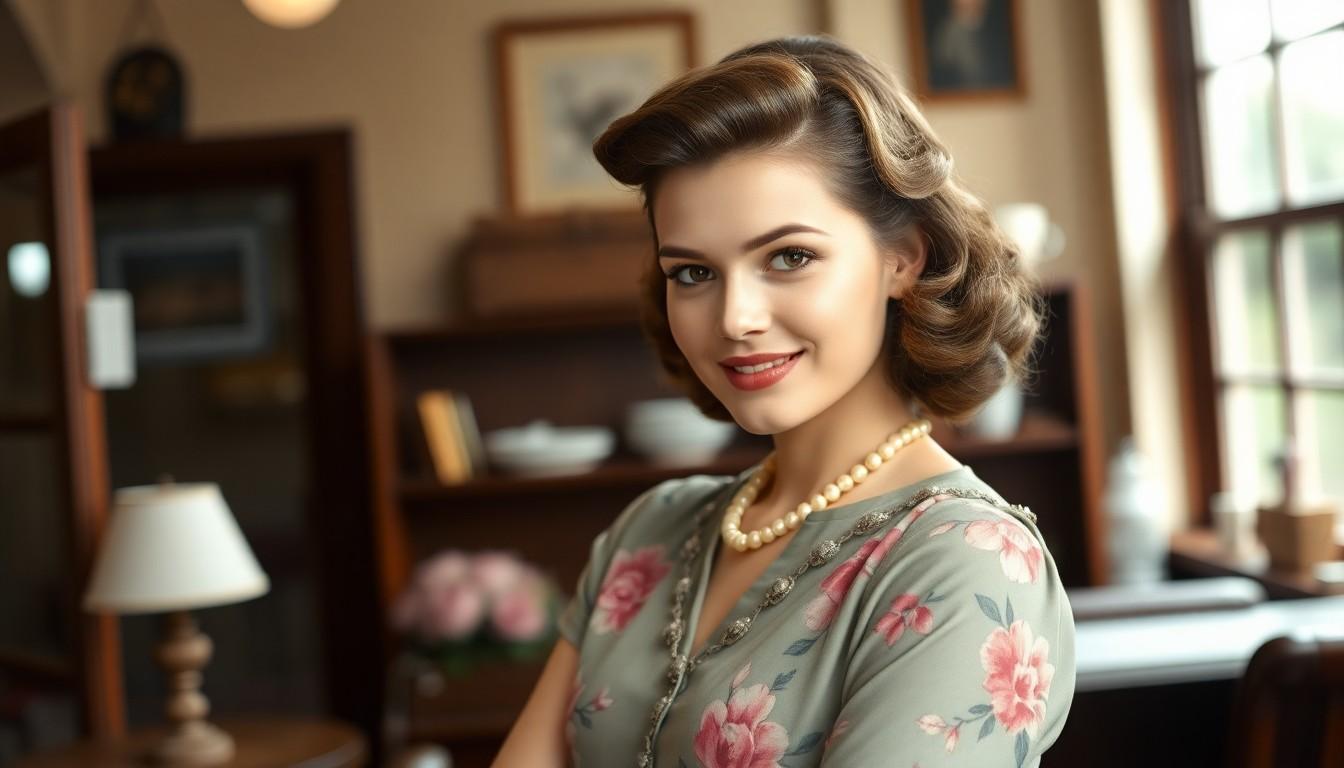
While the idea of pompadours often sparks images of hair swept high and away from the face, the 1940s actually centered on softer, more practical styles. This section looks at how the pompadour element was understood in the era, clarifying its place among more dominant trends.
The Rising Trend of Pompadours in the 40s
Some might think pompadours were everywhere in the 1940s, but records show they weren’t a mainstay for women at the time. Most women chose styles with gentle waves and curls rather than the lifted drama of a true pompadour. Evidence from period photographs and style guides shows that fuller shapes came instead from rounding cuts at the back and rolling sections strategically. Occasional volume in the front resembled a small pompadour effect, yet it never stole the spotlight from victory rolls or classically curled looks. Our vintage inspirations from Hollywood icons rarely sport true pompadour volume but rather favor softly pinned-up styles for daily wear.
Styling Techniques for a Voluminous Pompadour
Creating a 1940s-inspired pompadour means starting with natural texture and using the styling tricks of the times. We would reach for pins, rollers, and setting gels as women did then to coax height in selected front sections. Sectioning off the hairline, we’d gently tease or backcomb before rolling the strand upwards — securing it discreetly with bobby pins. Sometimes, curling the ends before rolling helped achieve a fuller, rounder lift without the hard shape of later pompadours. Adding a light mist of hairspray or setting lotion, we’d keep everything in place, mimicking the controlled volume without sacrificing softness. Our take prioritizes natural fullness using period-appropriate methods, staying true to the understated elegance that defined 1940s hair.
Recreating the Timeless Pageboy Cut
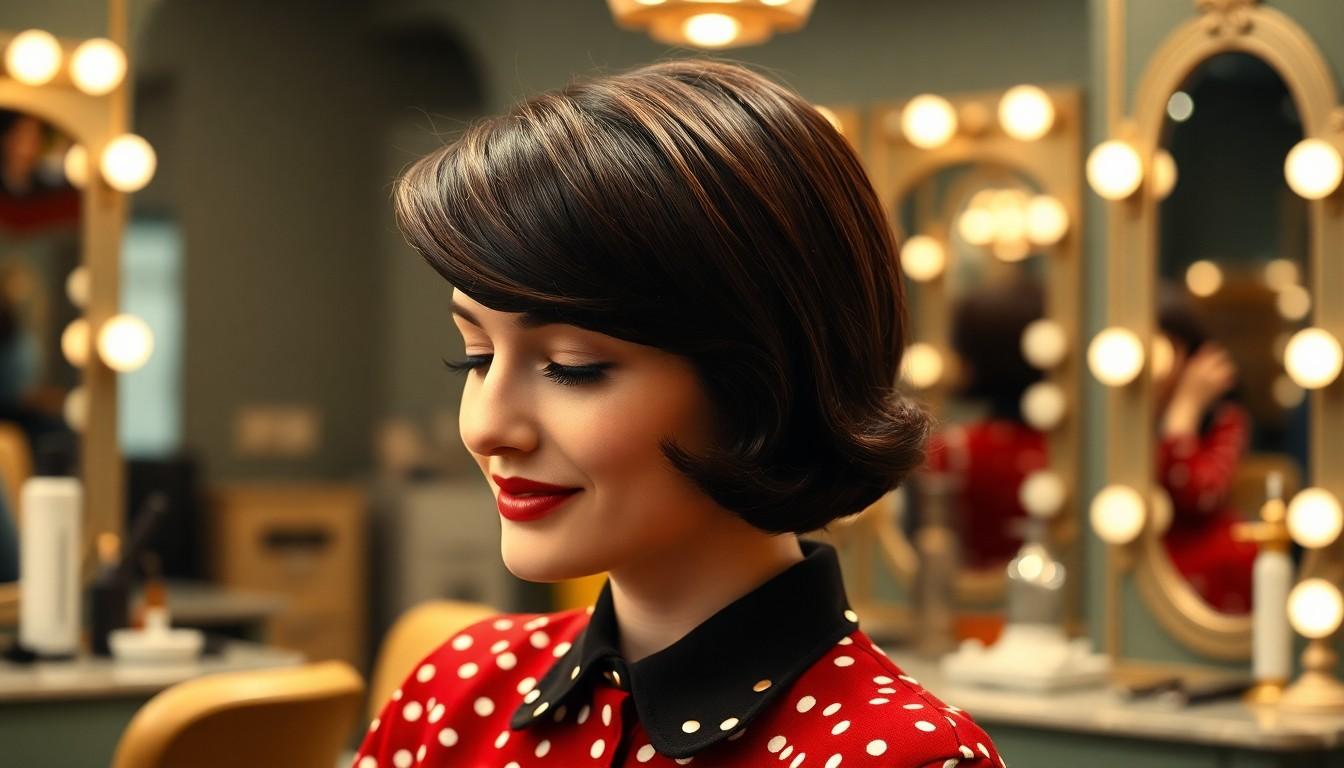
We can easily see why the Pageboy cut became an icon of 1940s style. Its structured lines offer a polished, everyday look that’s simple to recreate and versatile enough for modern wear.
Origins of the Pageboy Style in the 40s
Pageboy cuts made a splash in the 1940s because women needed hair that balanced style with practicality. War brought fabric and time shortages so manageable hairstyles gained popularity. The Pageboy fit right in, delivering a neat chin-or-shoulder length silhouette, often rounded at the back and curving softly toward the nape. Glamorous film stars favored this tidy but feminine style during a time when loose, easy elegance stood out against the decade’s upswept and voluminous alternatives.
Maintaining and Styling a Flawless Pageboy
Daily brushing keeps our Pageboy smooth and tangle-free. Light styling products, such as a dab of hair gel or pomade, help us sculpt the signature straight edge and subtle U-shape at the back without making hair heavy. For waves or added bounce, pin curls or victory rolls create gentle volume, just like women did in the 1940s. Keeping regular salon appointments ensures the cut stays even and sharp around the jawline, which is essential for that clean, iconic finish. When we want extra shine, a drop of serum or light oil quickly polishes the look and keeps layers in place.
Channeling Old Hollywood with Waves
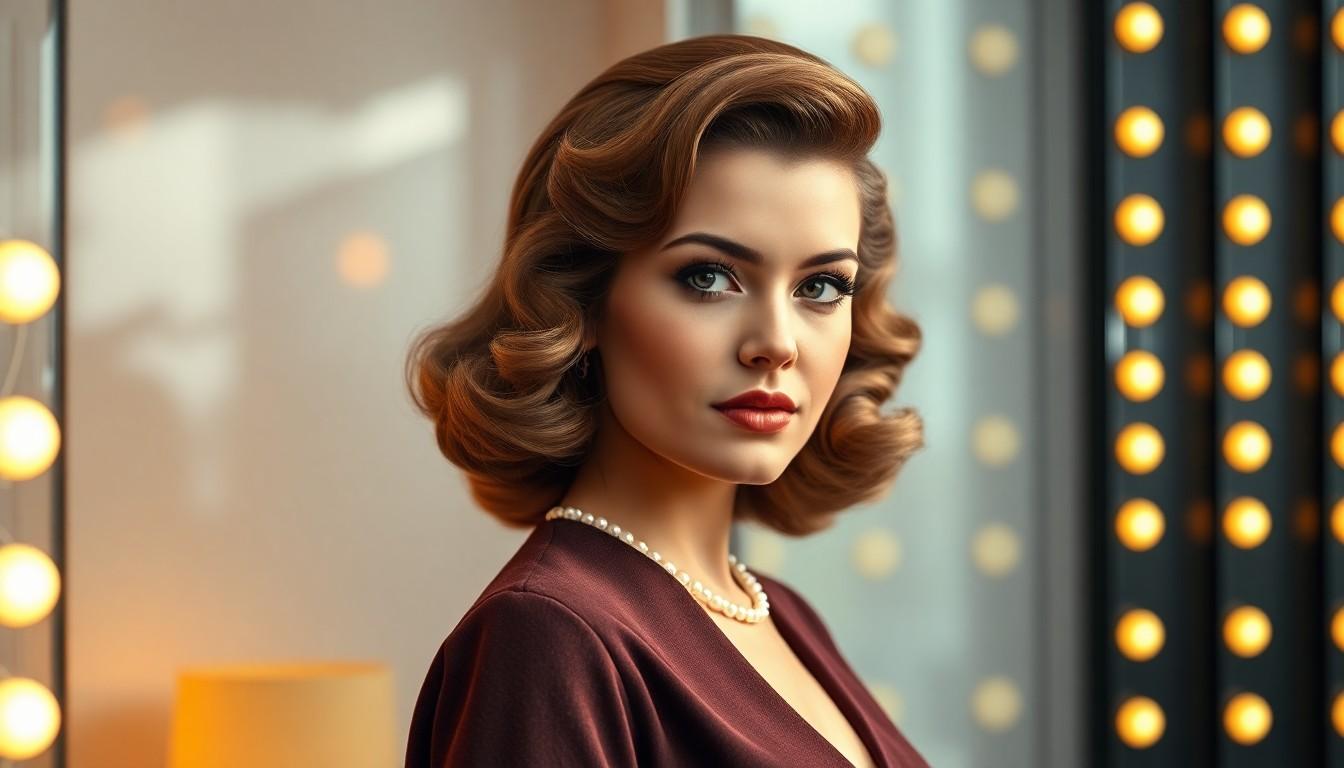
Nothing captures 1940s style quite like soft, polished waves that echo the elegance of classic film. Let’s see how cinema’s most glamorous women shaped these looks and find out exactly how we can create that lustrous finish today.
Hollywood Influence on 40s Hairstyles
Screen legends set the tone for everyday glamour. Veronica Lake and Lauren Bacall inspired millions of women to try feminine waves that framed their faces with immaculate precision. We watched movies and copied these stars by styling our hair just below shoulder length, cut in a rounded U-shape and shaped to curve gently at the sides.
Studios dictated the signature curls and always kept hair neat and brushed. Wartime realities forced many of us to favor practical, easy-to-maintain styles without sacrificing sophistication. Simple updos, elegant pin-up rolls, and soft waves let women feel chic whether they were at work or on an evening out.
We constantly saw glossy, perfectly arranged waves on popular actresses and aimed to mirror the effect at home using bobby pins and patience.
Tutorials for Achieving Soft, Glossy Waves
Recreating that Old Hollywood wave takes only a few steps. We usually start with freshly washed, damp hair, then detangle with a fine-tooth comb. Applying a little styling cream helps boost shine and hold.
Sectioning the hair comes next, since pin curls form the base of this style. We grab a small section of hair, coil it flat against our head, and secure each curl with a bobby pin. For most of us, letting them set overnight delivers the smoothest effect.
Victory rolls add flair for those who want something dramatic. We separate out sections near the front, roll them back, and pin securely to achieve that iconic 1940s silhouette. Once the curls set, we gently comb through or separate them with fingers to loosen them into lush, face-framing waves.
A light mist of hairspray is all we need to keep the style intact. Many of us flatten the top of the hair so hats fit snugly, a trick borrowed from the era. The result: soft, shiny Hollywood-inspired waves—always glossy, always polished, and unmistakably timeless.
Adopting Practical Snoods and Hair Scarves
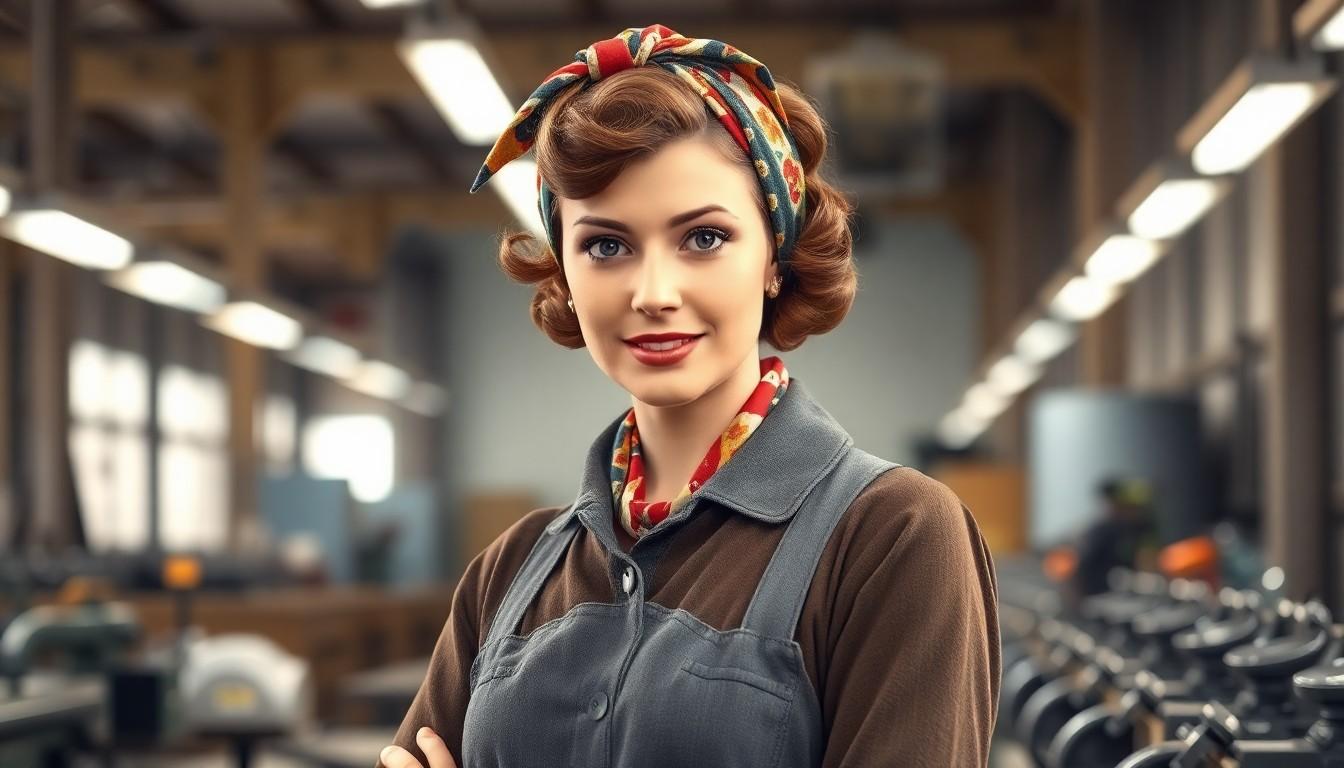
Let’s talk about the practical side of 1940s hair. Snoods and hair scarves weren’t just stylish—they were essentials that helped women manage their hair while adapting to the demands of daily life during Industry War II.
The Necessity of Snoods During Industry War II
Many women entered the workforce, and especially in factories or industrial jobs, snoods became a must-have. These accessories kept hair secure and away from dangerous machinery, significantly reducing the risk of accidents. Every day, we’d see women reaching for these netted coverings not only for safety but also because they were officially recommended on the job. Wartime conditions didn’t allow for loose hair, so snoods became the go-to solution for keeping everything tidy, practical, and compliant.
Creative Ways to Wear Hair Scarves and Snoods
Everyone embraced different ways to style snoods and hair scarves. Some of us tied snoods at the back of the head, while others wore them turban-style, blending protection with flair. Hair scarves got knotted or bowed over the ear, wrapped as casual headbands, or spiraled around a bun for a touch of everyday elegance. We loved combining them with curls, soft waves, or even dramatic victory rolls. There was always room for personal style, so these accessories worked not just to protect our hair but to let individual creativity shine right through the 1940s.
Modern Twists on Fascinating 40s Hairstyles
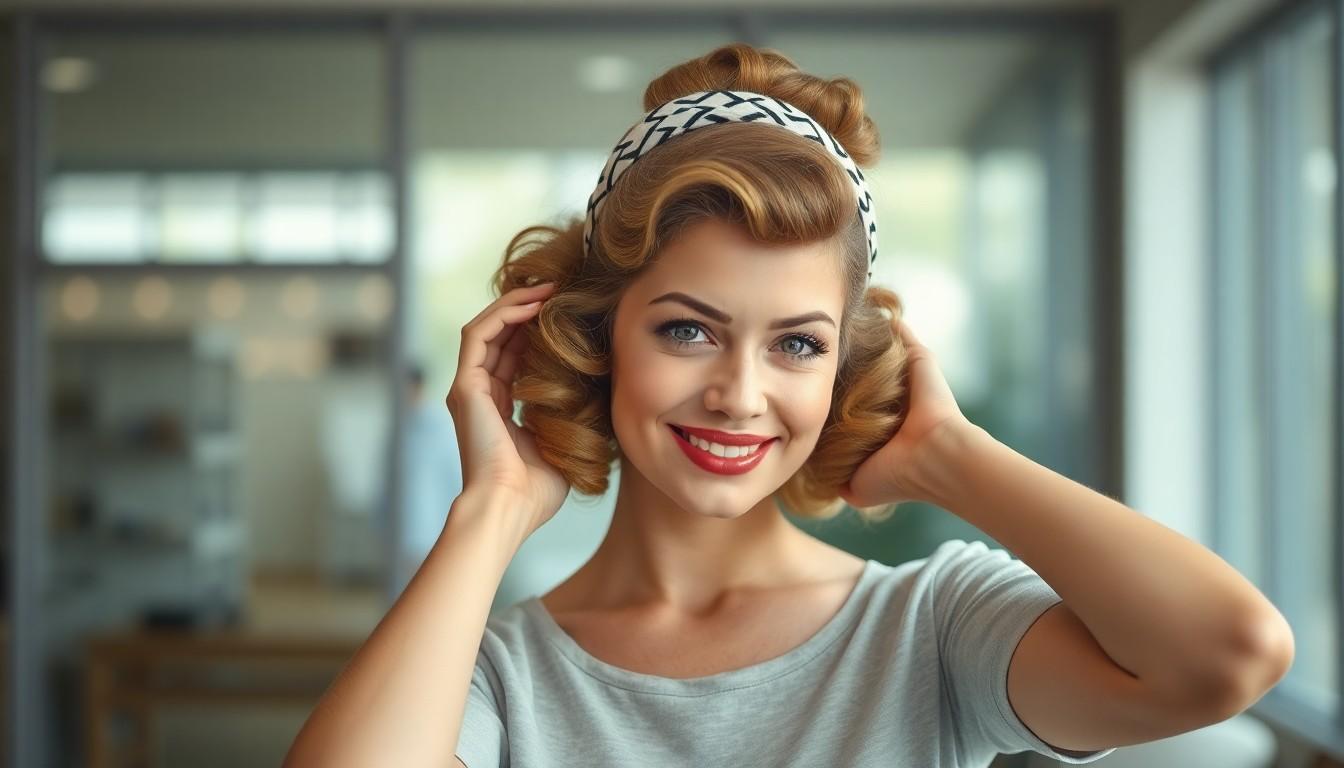
Let’s bring the vintage elegance of 1940s hair into the present with style and ease. Across runways and real life, we’re loving how these looks adapt so well for today.
Contemporary Inspiration from 1940s Looks
We find so much inspiration in the way 1940s hairstyles transition from daytime to evening. It takes just a simple adjustment to carry styles like the “Leona” from a work-friendly updo to a glamorous evening roll. Adding a hair scarf or headband instantly gives any updo a pop of vintage charm—try tying a scarf around your head, letting it double as a headband, or weaving it into a ponytail for a playful update. Mixing styling techniques pays off as well. For example, rolling the top section of hair diagonally then bricklaying the rest, paired with modern products like TRESemmé Flawless Curls Extra Hold Mousse, lets us recreate that classic curl with a fresh finish. Soft, gently brushed curls inspired by the combed-through 40s look get a wearable refresh by starting curls at the hairline and blending them seamlessly with today’s tools and sprays.
Adapting 40s Hairstyles for Today’s Trends
We love how these nostalgic styles fit right into modern life. Using mousse, hairspray, and curl-defining creams means vintage curls and victory rolls last longer and look less stiff, supporting all-day wear for both work and casual hangouts. Modern tools like foam rollers or heated curlers make pin curls and victory rolls quick and consistent, giving us that 1940s silhouette in half the time. Personalizing the classics feels fun—sometimes we’ll twist the front into a subtle pompadour and leave the rest loose and curly, or secure just one side with a vintage clip for a balanced blend of retro and now. The versatility of these styles lets us move from office meetings to evening events with just a touch-up or added accessory, proving just how right the 40s got it.
Conclusion
Exploring 1940s hairstyles lets us tap into a industry where elegance meets everyday practicality. Whether we’re drawn to the drama of victory rolls or the soft allure of polished waves, these vintage styles offer endless inspiration for our modern routines.
By experimenting with classic techniques and adding our own twist, we can bring a touch of timeless glamour to any occasion. Let’s celebrate the spirit of the 1940s and make these iconic looks our own, blending history with today’s fashion confidence.
Frequently Asked Questions
What are the most iconic 1940s hairstyles?
The most iconic 1940s hairstyles include victory rolls, pin curls, soft polished waves, the Pageboy cut, and pompadours. Each style blends elegance with practicality, reflecting the era’s Old Hollywood glamour and wartime sensibility.
How do you create victory rolls at home?
To create victory rolls, section your hair, roll each section inward toward the scalp, secure with bobby pins, and use hairspray to set. Starting with slightly damp or pre-curled hair helps achieve volume and hold. Practice and patience make perfect!
What are pin curls and why were they popular?
Pin curls are small, tightly wound sections of hair secured with pins. They were popular in the 1940s for creating soft waves and volume. Women favored them for their feminine, glamorous look and adaptability to different hair lengths.
What is the 1940s Pageboy cut?
The Pageboy cut features straight, shoulder-length hair with turned-under ends and a smooth, structured silhouette. It gained popularity in the 1940s for its polished appearance and easy maintenance, fitting the needs of busy women during wartime.
How did women in the 1940s style their hair for work?
Women often used snoods and hair scarves to keep hair neat and safe, especially in factories or jobs involving machinery. These accessories offered practicality, prevented accidents, and allowed personal style through patterned fabrics and creative wrapping.
Are 1940s hairstyles suitable for modern fashion?
Yes, 1940s hairstyles suit modern fashion and can be easily adapted with current styling tools and products. Styles like soft waves, victory rolls, and pin curls remain popular for their timeless elegance and can complement both casual and formal looks.
How do you make 1940s hairstyles last all day?
Use setting products like mousse or setting spray, style with rollers or pin curls for strong hold, and secure with pins. Allow styles to cool completely before removing pins, and finish with a light mist of hairspray for long-lasting results.
Can short hair be styled in 1940s looks?
Absolutely! Styles like pin curls and the Pageboy are great for short hair. Use smaller sections and lots of pins for victory rolls or waves. 1940s trends are flexible and work with a variety of hair lengths and textures.
What hair products help achieve 1940s hairstyles?
Hair mousse, setting gel, bobby pins, rollers, and hairspray are essential. Modern heated curlers can replace traditional rollers for convenience. A boar bristle brush helps achieve smooth, glossy waves reminiscent of 1940s glamour.
Which Hollywood stars inspired 1940s hairstyles?
Hollywood legends such as Rita Hayworth, Veronica Lake, and Lauren Bacall inspired 1940s hair trends. Their iconic waves, rolls, and structured cuts influenced women worldwide and continue to shape vintage-inspired looks today.

